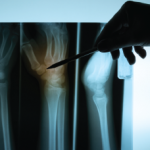Payment for medical evaluation and management (E&M) services has improved under the pathway, he added. The payer supplies an iPad computer and proprietary software for patients and physicians to enter essential authorizing information and to report outcomes—including pain and severity scales assessed by the physician. However, under the pathway, providing RA treatment infusions in an acute hospital, rather than an outpatient setting, is viewed by the payer as noncompliance.
Dr. Borenstein’s group has not participated in the program for very long, so “at this point, I have more questions about it than answers,” he said. However, if the process allows for give and take, for the ultimate benefit of the provider, patient, and payer, then it will be a significant step forward in healthcare delivery, he noted.
Radiographic Evidence Isn’t Always What it Seems
Edward Keystone, MD, professor of medicine at the University of Toronto, Canada, reviewed current trends and recent research in the treatment of RA, focusing on radiographic outcomes—a key measure of irreversible joint damage—and their role in defining treatment. “Things are not always what they seem,” when it comes to evaluating and treating RA, he said. Trying to reconcile discrepancies between radiographic versus clinical evidence in guiding treatment decisions presents challenges for the clinician.2 “But if one is aware of the pitfalls of these definitions, one will be better at interpreting the results of the studies.”
Remission in RA is a complex topic, but “is it really remission that we’re shooting for?” Dr. Keystone posed. “How is remission defined in RA? How do you interpret nonresponse?” Radiographic remission is characterized by the absence of significant synovitis upon sensitive imaging, whereas true RA remission is defined as a state of low disease activity with no progression of structural damage to the joints.
What causes clinical inflammation is not what causes joint damage, Dr. Keystone said. Clinical remission in response to treatment is not as easy to achieve as radiologic remission. Some patients don’t have a good response to treatment, yet, according to the radiologic evidence, their disease is not progressing, while others would fit definitions of remission. Still, the radiologic evidence shows that the disease is progressing. Nonresponders to methotrexate or biologics, as measured by radiographic evidence, sometimes improve significantly in terms of symptoms and functioning.
Timing of response to treatment can be just as important as the target reached when it comes to predicting long-term outcome, Dr. Keystone said, since rapid control of symptoms—within 12 weeks—is correlated with positive outcomes in the long run. Elaborating on the other trade-offs that rheumatologists must consider, he said that diagnosing from the imaging alone, without clinical evidence such as evaluation of joint swelling, will give a different and perhaps incomplete picture of what is really going on. Swollen joints are more important than tender joints in defining progression of disease, and joint space narrowing is more important than joint erosion. Composite indices such as ACR-20 still allow for a degree of clinical symptoms or evidence of synovitis when achieving remission.

